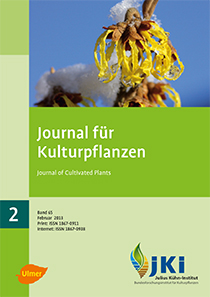Detection of Iris yellow spot virus (IYSV) in selected Allium species and overwintering hosts in Austrian onion-producing areas
DOI:
https://doi.org/10.5073/JfK.2013.02.03Keywords:
Thrips tabaci, Allium spp., tospovirus, detection in onion bulbs, first report on leek, AustriaAbstract
Iris yellow spot virus (IYSV) has been reported for the first time in USA in 1989. Rapid spread of this viral pathogen has occurred in the western United States. IYSV has been frequently reported from most onion-production regions of the United States and many areas of the world in recent years. In 1998 it has been reported for the first time for Europe, in the Netherlands on Iris hollandica. Shortly afterwards it could be detected on onion in Israel. In Austria the first report of IYSV occurred in 2009. It is not seed born and only vectored by onion thrips (Thrips tabaci).
As a result of our investigations all onion-producing areas in Austria tested positive for IYSV with DAS-ELISA in 2010. Leek has been tested IYSV-positive for the first time in Austria. Additionally IYSV could be detected in onion bulbs, which represents the third report worldwide and the second for Europe. The influence of weed hosts for the overwintering and distribution of the virus are undetermined to date. Eleven weed species have tested positive using DAS-ELISA, six species have been found out to be new hosts for IYSV according to this method. Nevertheless, none have been confirmed using the RT-PCR.
Published
Issue
Section
License
The content of the journal is licensed under the Creative Commons Attribution 4.0 License. Any user is free to share and adapt (remix, transform, build upon) the content as long as the original publication is attributed (authors, title, year, journal, issue, pages).
The copyright of the published work remains with the authors. The authors grant the Journal of Cultivated Plants, the Julius Kühn-Institut and the OpenAgrar repository the non-exclusive right to distribute and exploit the work.







